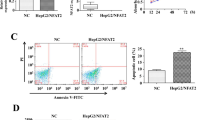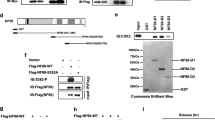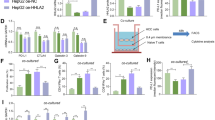Abstract
Background and Aims
The nuclear factor of the activated T cell (NFAT) family was primarily recognized for its central role in T lymphocyte activation. Recent evidence showed that NFAT isoforms participate in the regulation of genes related to cell proliferation and differentiation in epithelial malignancies. Here, we investigated the expression and activation of the calcineurin/NFAT transcription pathway and its role in hepatocellular carcinoma (HCC) proliferation.
Methods
Expression of NFATc1 and calcineurin proteins was examined by immunohistochemical analyses in 76 human HCC samples. The cellular NFAT activation and distribution in HepG2 cells were analyzed by immunofluorescence and western blot analyses. After NFATc1 expression was knocked down by NFATc1-specific siRNA, we analyzed its implications in cell cycle progression and growth by MTT and flow cytometry. The impact of calcineurin/NFAT signaling on protein expression of c-myc and cox-2 were performed by western blot analyses.
Results
NFATc1 is significantly overexpressed in HCC. The regulation of calcineurin activity by ionomycin or cyclosporin A caused rapid nuclear import or export of NFATc1 in HepG2 cells. NFATc1 knock-down led to a significant reduction in proliferation rates and cell cycle arrest at G1 phase. The expression of c-myc and cox-2 was decreased in the NFATc1 knock-down HepG2 cells. Ionomycin increased c-myc and cox-2 expression in HepG2 cells, but not in siNFATc1 HepG2 cells.
Conclusion
The calcineurin/NFATc1 signal is overexpressed and active in HCC. It may enhance the proliferative potential of HepG2 cells through transcriptional activation of the c-myc and cox-2 oncogenes.






Similar content being viewed by others
References
Macian F. NFAT proteins: key regulators of T-cell development and function. Nat Rev Immunol. 2005;5:472–484.
Lu H, Huan C. Transcription factor NFAT, its role in cancer development, and as a potential target for chemoprevention. Curr Cancer Drug Targets. 2007;7:343–353.
Müller MR, Rao A. NFAT, immunity and cancer: a transcription factor comes of age. Nat Rev Immunol. 2010;10:645–656.
Oum JH, Han J, Myung H, Hleb M, Sharma S, Park J. Molecular mechanism of NFAT family proteins for differential regulation of the IL-2 and TNF-alpha promoters. Mol Cells. 2002;13:77–84.
Horsley V, Aliprantis AO, Polak L, Glimcher LH, Fuchs E. NFATc1 balances quiescence and proliferation of skin stem cells. Cell. 2008;132:299–310.
Neal JW, Clipstone NA. A constitutively active NFATc1 mutant induces a transformed phenotype in 3T3-L1 fibroblasts. J Biol Chem. 2003;278:17246–17254.
Giglia JL, Antonia SJ, Berk LB, Bruno S, Dessureault S, Finkelstein SE. Systemic therapy for advanced hepatocellular carcinoma: past, present, and future. Cancer Control. 2010;17:120–129.
Mahnken AH, Bruners P, Günther RW. Local ablative therapies in HCC: percutaneous ethanol injection and radiofrequency ablation. Dig Dis. 2009;27:148–156.
Boucher E, Forner A, Reig M, Bruix J. New drugs for the treatment of hepatocellular carcinoma. Liver Int. 2009;29:148–158.
Shaw JP, Utz PJ, Durand DB, Toole JJ, Emmel EA, Crabtree GR. Identification of a putative regulator of early T cell activation genes. Science. 1988;241:202–205.
Mancini M, Toker A. NFAT proteins: emerging roles in cancer progression. Nat Rev Cancer. 2009;9:810–820.
Kao SC, Wu H, Xie J, et al. Calcineurin/NFAT signaling is required for neuregulin-regulated Schwann cell differentiation. Science. 2009;323:651–654.
Gordan JD, Thompson CB, Simon MC. HIF and c-Myc: sibling rivals for control of cancer cell metabolism and proliferation. Cancer Cell. 2007;12:108–113.
Singh G, Singh SK, König A, et al. Sequential activation of NFAT and c-Myc transcription factors mediates the TGF-beta switch from a suppressor to a promoter of cancer cell proliferation. J Biol Chem. 2010;285:27241–27250.
Cervello M, Montalto G. Cyclooxygenases in hepatocellular carcinoma. World J Gastroenterol. 2006;12:5113–5121.
Stasinopoulos I, O’Brien DR, Wildes F, Glunde K, Bhujwalla ZM. Silencing of cyclooxygenase-2 inhibits metastasis and delays tumor onset of poorly differentiated metastatic breast cancer cells. Mol Cancer Res. 2007;5:435–442.
Acknowledgments
This work was supported by grants from Youth Fund of Science and Technique of Heilongjiang Province of China (QC2010015) and Scientific Research Fund of the Affiliated Tumor Hospital of Harbin Medical University (JJ2008-15).
Conflict of interest
None.
Author information
Authors and Affiliations
Corresponding author
Additional information
Shuhuai Wang and Xinmei Kang contributed equally to the manuscript.
Rights and permissions
About this article
Cite this article
Wang, S., Kang, X., Cao, S. et al. Calcineurin/NFATc1 Pathway Contributes to Cell Proliferation in Hepatocellular Carcinoma. Dig Dis Sci 57, 3184–3188 (2012). https://doi.org/10.1007/s10620-012-2255-8
Received:
Accepted:
Published:
Issue Date:
DOI: https://doi.org/10.1007/s10620-012-2255-8




